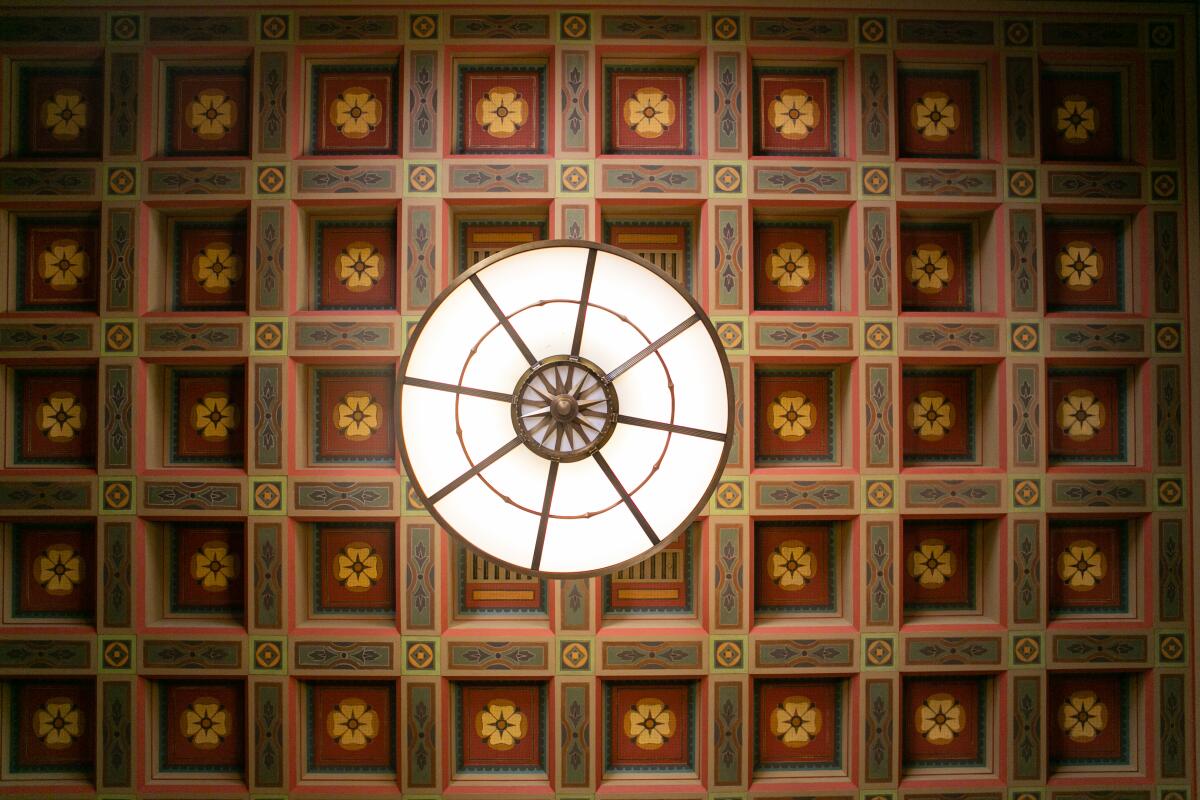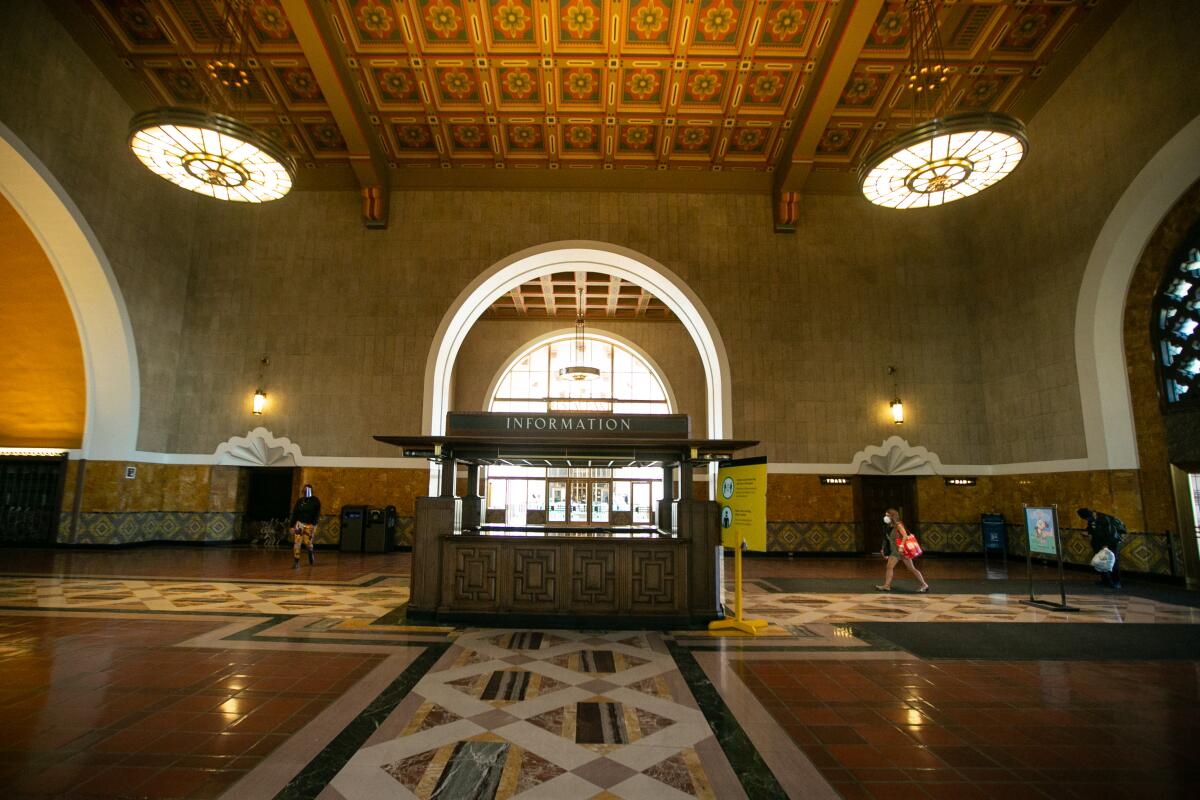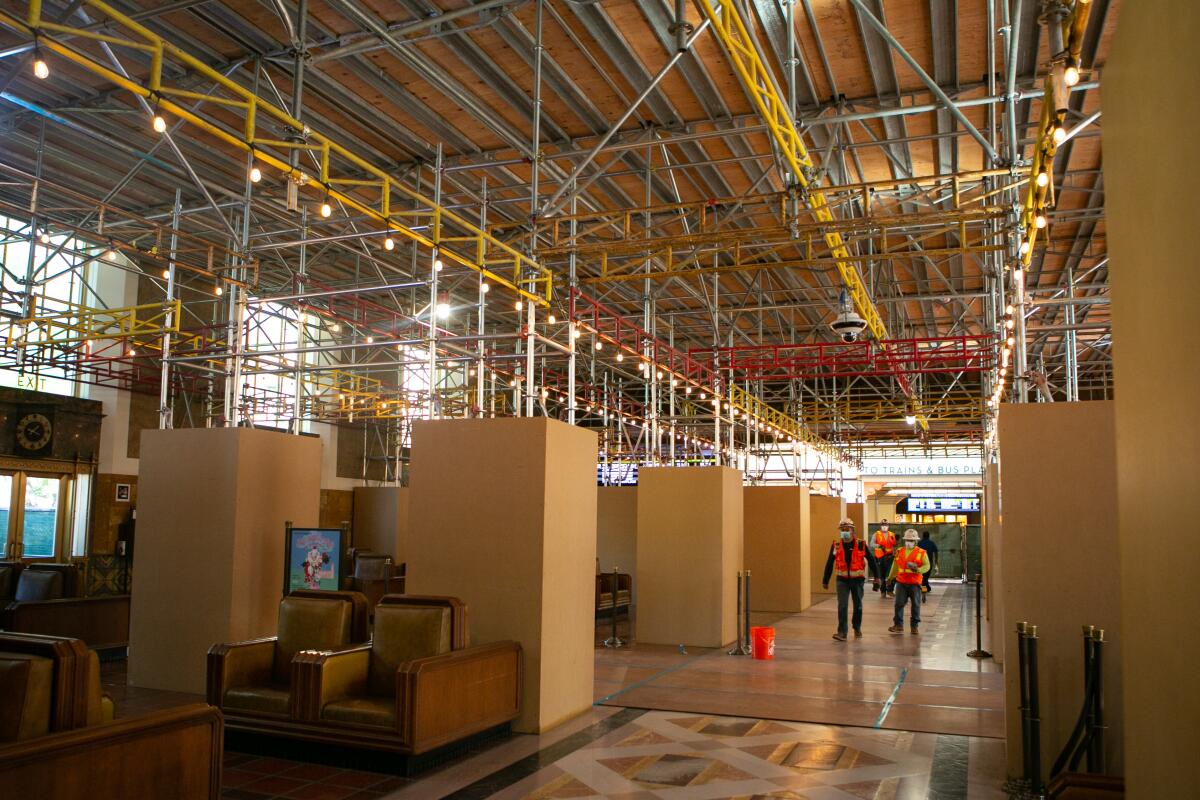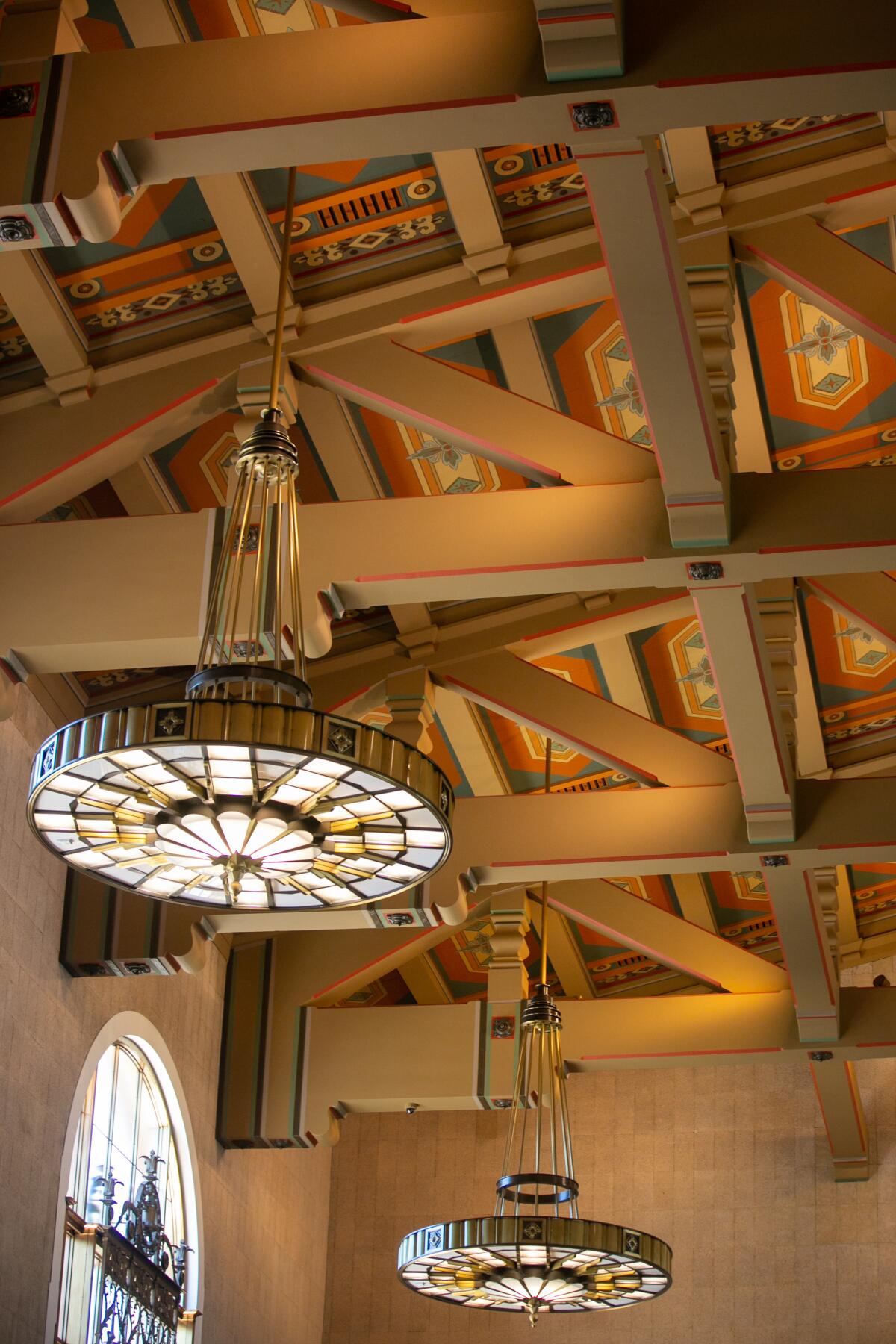Art in L.A.’s Union Station has been hidden for decades. Now it prepares for an Oscar debut

- Share via
It was after midnight on a June evening in 2017 when the discovery was made. Union Station’s entry vestibule — an ode to Mission Moderne architecture, with its Spanish tile floor and draping Art Deco chandeliers — was virtually deserted. A restoration cleaning crew was wiping down the tarnished ceiling panels, dim, brownish squares that hadn’t been cleaned in nearly 80 years and were so caked with tobacco tar and dirt that they appeared to be solid wood rather than painted plaster.
For the record:
3:00 p.m. April 19, 2021A previous version of this story identified Union Station’s construction manager as Dyana Elan. Her last name is Elam.
One of the two workers, perched on a boom lift about 40 feet high, gently wiped a section of the ceiling with cleaning solution, causing a swath of bright orange to appear. Repeated cleaning soon revealed bits of yellow and peach shining through. Below the darkened surface, there was a vibrant painting, original to the architecture, bearing a floral pattern.
“It was like, wow! We knew there was something under there, but we had no idea it was this brightly colored pattern,” said Dyana Elam, construction manager of Union Station. “It was a really interesting discovery.”

The ceiling cleaning was part of an eight-year, $4.1-million restoration that began in 2013 and ended in March. The project — the first of a three-phase overhaul of the station — included cleaning and restoration of the station’s chandeliers, restoration of the black walnut ticket concourse counter, repair of broken acoustic and ceramic tiles on interior walls, the cleaning and sealing of brass- and bronze-trimmed windows, doors and storefronts, and restoration of the building’s clay tile roof. The work was executed by a variety of specialty contractors. It was EverGreene Architectural Arts that made the painting discovery.
The now-gleaming train station will get its close-up this Sunday when the 93rd Academy Awards ceremony is broadcast live from throughout its historic halls. (Elements of the show also will be broadcast live from Hollywood’s Dolby Theatre.) Nominees, their guests and presenters will be in attendance at Union Station with COVID-19 safety protocols in place. On April 29, the restored space will open to the public, its big reveal.
Oscar-level drama is not new to Union Station. The eight-year renovation was full of mystery, intrigue and challenges around seemingly every turn.
As it turns out, versions of the ceiling painting, California wildflowers by L.A. artist Herman Sachs, bloom brightly throughout the station, the work crew discovered. They appear on floor and wall tiles as well, uniting the station’s design. And there’s a slightly different color palette in each room. The entry vestibule ceiling is awash in warm tones of orange, yellow and peach, but cleaning the ticket concourse ceiling revealed more green, and restoring the waiting room ceiling uncovered purple and lavender.
Cleaning the ceilings, however, also revealed massive deterioration. There was more significant water damage in the entryway than anyone had expected, and several parts were moldy. Chunks of plaster had fallen from the panels and beams — or were in danger of falling and injuring visitors. Several panels had been hastily repaired in the past, sloppily patched with paint that didn’t match the original design.
“It almost looked like a Dalmatian, with dark spots everywhere,” Elam said. “We saw all the imperfections and it was like: Oh, my god, what do we do?”

Maintaining the historical integrity of architecture by the father-son team John and Donald B. Parkinson was of primary importance. In 2011, the Los Angeles County Metropolitan Transportation Authority purchased Union Station in a state of disrepair, Elam said. The recent renovation was the station’s first major face-lift since opening in 1939, Elam said, and the agency wanted to do it right.
However, there was only very old documentation of Union Station’s construction to work with — black and white photographs of the building going up, hand-drawn building plans, hard-to-decipher scribbled notes and old shop drawings from more than 80 years ago. So there was no way to determine the original ceiling paint colors. Nor was there a written record of the original paint materials used, leaving the restoration crew guessing as to whether the paint was oil based or water based.
Is a tiny house really a glorified toolshed? Are the unhoused serving as guinea pigs for architect’s design experiments? Our columnist visits L.A.’s new wave of shelter solutions.
“We felt it was important to try to stay as close to the original paint composite as possible because we didn’t know whether or not the artist was going for a certain look,” Elam said. “Depending upon the type of paint you use, you can get very different results.”
A forensic investigation ensued in 2017, led by Architectural Resources Group, that included a microscopic evaluation of materials in the ceiling. A historical preservation consultant from ARG photographed areas and took samples away in baggies, to be analyzed in a lab. “Similar to what you’d see in a crime show,” Elam said. Sometimes she dug through up to seven layers of paint to unearth what she hoped was the historic layer.
“We didn’t want to go back in with anything that wasn’t historically accurate,” Elam said.
The investigation extended to other parts of the building and turned up surprises. Black-painted bells on the exterior of the building that were presumed to be solid cast iron turned out to have 24 karat gold leaf filigree. They were restored to their original intent. Grills covering electrical panels in the ticket concourse that were long thought to be black-painted cast iron turned out to be a gold-colored mix of bronze and aluminum. Black air conditioning vent grills revealed, after cleaning, the color turquoise beneath.
“All those colors, they tell a story,” Elam said. “We look at the station as a whole piece of art, and if the colors aren’t true to the original intent, then we’re doing a disservice to the artist.”
March 2020 brought more drama. When COVID-19 hit, the project’s fate suddenly hung in the balance.
“There was a lot of unknown, a lot of uncertainty,” Elam said. “Changes had to be made in terms of job site cleanliness, understanding spacing for the teams.”
With fewer people working at once, Elam expected slower progress over a longer period of time — and more money spent. But the opposite turned out to be true.
Cinerama Dome is L.A. Historic-Cultural Monument No. 659. City and preservation officials explain what that means for protection against demo or gutting.
With the station virtually empty as of mid-March last year, the team was able to accelerate renovation, particularly in mid-2020 when it started prepping restoration of the typically bustling waiting room. Instead of sectioning off areas with scaffolding so that passengers could move safely around the construction, and then having to deinstall and reinstall the scaffolding elsewhere in the room as work progressed, the restoration team took over the space freely and was able to work faster, even socially distanced. (A COVID-19 testing kiosk that opened at Union Station in September is outdoors, in the South Patio.)
“A lightbulb went off,” Elam said. “Let’s seize this opportunity and really push this thing through.”

The ticket concourse ceiling project, which involved cleaning, patching 70,000 linear feet of plaster and repainting panels, was completed a year ago. Around that time, the team discovered a ceiling beam, dated 1945, with signatures on it. It’s construction tradition that when a building’s steel substructure is nearing completion, the team signs the final beam before it’s hoisted and secured in place. But a mystery remains: The building was completed in 1939, not 1945.
“We believe the ceiling was still under construction in one way or another then,” Elam said. “Maybe the ceiling was still being painted years after the station opened.”
The ceiling in the cavernous waiting room, with its restored Art Deco wood and leather chairs, was the last stage of the renovation.
A protective coating wasn’t applied to any of the ceilings so as not to inhibit future restoration efforts.
“It can be detrimental when you try to go back later on and try to do what we did,” Elam said, “which is investigate or identify the progression of what has been done.”
The next two phases of renovation are “unsexy” but much needed, Elam said. Phase 2, safety and security projects, is well underway and will be completed in late 2022. It includes Americans With Disabilities Act improvements such as wheelchair ramps and automatic openers on historic doors, upgraded internet and enhanced security and fire safety systems.
Phase 3, creature comfort projects, will be finished in 2023. It includes renovation of the parking lots, plumbing infrastructure and ticket concourse restrooms, among other things.
Expect drama, even in the benign.
“Things aren’t always as they seem on the surface here,” Elam said. “If you dig a little deeper, you can end up finding a lot more information that you didn’t originally anticipate.”
Ovation Award organizers mistake nominee Jully Lee for a different Asian actor. In protest, the city’s largest theaters pull out of the L.A. Stage Alliance.
More to Read
The biggest entertainment stories
Get our big stories about Hollywood, film, television, music, arts, culture and more right in your inbox as soon as they publish.
You may occasionally receive promotional content from the Los Angeles Times.












